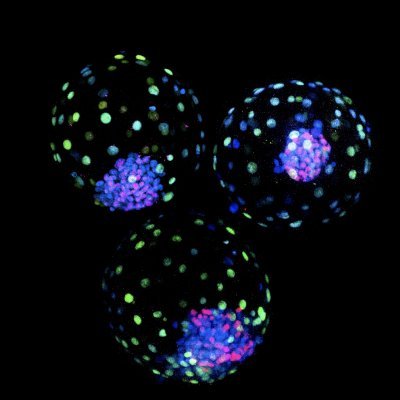
Monika Mohenska
@m_mohenska
Followers
403
Following
5K
Media
106
Statuses
2K
Cell Fate Fanatic | Epigenetics Enthusiast | Bioinformatician @ the POLO LAB | Occasional Artist - Views are my own 🤍
Australia
Joined November 2017
🚀🔬 Exciting news! 📢 The latest paper from Polo and Lister labs is here! 🧪🔍 Discover groundbreaking insights into transient naive treatment reprogramming. 🌟 Don't miss out on this game-changing study! 📄🔝#CellularReprogramming #Epigenetics
https://t.co/i0DBC34STA
nature.com
Nature - A new reprogramming strategy used to produce human induced pluripotent stem cells from somatic cells results in epigenetic and functional profiles that are highly similar to those of human...
2
4
13
Nature research paper: Transcriptomic and spatial organization of telencephalic GABAergic neurons https://t.co/QaK0cds7vC
nature.com
Nature - Long-distance migration and dispersion is a common characteristic of nearly all classes of telencephalic GABAergic neurons, which diversify extensively after birth in the cortex and...
2
33
138
Pleased to share our latest paper in @CurrentBiology! We present the first chromosome-level genome of a phoronid and show that shared chromosomal fusions place phoronids and bryozoans as sister groups, resolving a century-old debate on lophophorates. https://t.co/oswu6xuvgf
7
36
120
Super interesting work 👏 mapping how brain endothelial cells communicate with astrocyte endfeet at the blood–brain barrier in @NatureComms The study identifies ligand–receptor pairs conserved in humans and altered in MS and Alzheimer’s. Makes me also wonder how many could be
2
27
118
Squidiff: a diffusion-based model to predict transcriptome response to perturbations. https://t.co/UcXhHZJzrg
5
93
609
ESPRESSO: a method that extracts functional information about organelles for deep spatiotemporal phenotyping at the single cell level. https://t.co/a2d7FGhJLT
2
20
81
By learning a differentiation potential using an optimal transport-based approach, STORIES models and infers cell fate trajectories using spatiotemporal omics data. @gjhuizing @JulesSamaran @gabrielpeyre @cantinilab
https://t.co/dG7HBQ09j8
nature.com
Nature Methods - By learning a differentiation potential using an optimal transport-based approach, STORIES models and infers cell fate trajectories using spatiotemporal omics data.
0
20
70
CRISPR live-cell imaging reveals chromatin dynamics and enhancer interactions at multiple non-repetitive loci https://t.co/5VtEnCmKEB
0
68
225
How do lung cancer cells and their inflammatory neighbors evolve together from the earliest precancerous stages?@MDAndersonNews @Cancer_Cell "Multimodal spatial-omics reveal co-evolution of alveolar progenitors and proinflammatory niches in progression of lung precursor
1
17
83
Congratulations Daniel, Daiji and the team! We took a loss of function approach to dissect Oct4 enhancer function in pluripotent stem cells and mouse embryogenesis!
cell.com
Schmitz et al. employ a loss-of-function strategy to dissect the roles of the Oct4 distal and proximal enhancers in PSCs and early mouse development. They reveal distinct, state-specific enhancer...
1
10
70
Mesenchymal thymic niche cells enable regeneration of the adult thymus and T cell immunity https://t.co/iqE2iMnho2
1
10
71
I just read the most important AI paper of 2025. Dartmouth + Stanford built NeuroBot TA an AI teaching assistant using Retrieval-Augmented Generation (RAG) that only answers from instructor-approved materials. That means accurate, contextual, and crucially no hallucinations.
13
61
303
We’re thrilled to share that our MERFISH+ preprint is now live on bioRxiv!👉 https://t.co/UOzYbgz6XL In this work, the Bintu and Zhu labs (UCSD) developed MERFISH+, a next-generation spatial genomics platform that combines genome-wide RNA and epigenetic imaging over a large field
7
59
258
🚀 Prophet v3 is out! AI that predicts how cells respond to genetic & chemical perturbations across readouts. Now scales to 1.9 M molecules + in vitro validation of melanoma-specific hits 🧬💊 📄 https://t.co/JTd0VQUXls
#AI #Biology #DeepLearning
4
51
195
Squidiff: Generative diffusion models for predicting cell fate and perturbation responses Single-cell sequencing lets us observe how individual cells differ, evolve, and respond to their environment. But while we can measure these transcriptomic states, predicting how a cell
4
55
329
Nature research paper: Multi-omic profiling reveals age-related immune dynamics in healthy adults https://t.co/lKMBA976WE
nature.com
Nature - This multi-omic longitudinal analysis of the healthy human peripheral immune system constructs the Human Immune Health Atlas and assembles data on immune cell composition and state changes...
2
82
310
Our spatio-temporal map of lesion repair in the heart at single-cell resolution is now published in @NatureCVR. https://t.co/90dWoRfL9i We dissected dynamics of multicellular niches that control cardiac repair. See 🧵for highlights.
3
24
113
Spatiotemporal gene expression and cellular dynamics of the developing human heart https://t.co/dTCudcphu2
nature.com
Nature Genetics - The authors use spatial and single-cell transcriptomics to examine spatial dynamics during early human cardiogenesis, yielding insights into the development of the cardiac...
0
23
114
Cell Decoder: decoding cell identity with multi-scale explainable deep learning. #SingleCellOmics #CellCharacterization @GenomeBiology
https://t.co/o4wJIDF3eZ
0
9
50
Epigenetics Update - A multimodal cross-species comparison of pancreas development https://t.co/Tx9yLCn0CB
#Epigenetics #Chromatin #Pancrease #Multiomics --- High-resolution insights without cell sorting; https://t.co/WmSYDGWPJD
1
7
36
Tahoe-x1: Scaling Perturbation-Trained Single-Cell Foundation Models to 3 Billion Parameters 1. Tahoe-x1 (Tx1) is a groundbreaking family of single-cell foundation models with up to 3 billion parameters, pre-trained on large-scale single-cell transcriptomic datasets, including
0
10
57






















